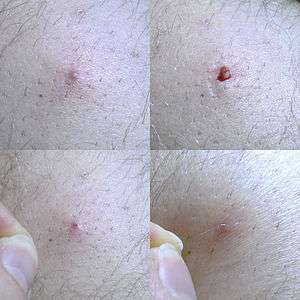Ingrown hair
Ingrown hair is a condition where a hair curls back or grows sideways into the skin. The condition is most prevalent among people who have coarse or curly hair. It may or may not be accompanied by an infection of the hair follicle (folliculitis) or "razor bumps" (pseudofolliculitis barbae), which vary in size. While ingrown hair most commonly appears in areas where the skin is shaved or waxed (beard, legs, pubic region), it can appear anywhere. Anything which causes the hair to be broken off unevenly with a sharp tip can cause ingrown hairs.[1] Ingrown hairs are also caused because of lack of natural exfoliation in the skin.
| Ingrown hair | |
|---|---|
 | |
| An ingrown hair | |
| Specialty | Dermatology |
Signs and symptoms
Symptoms include rash, itching skin, and hair which remains in spite of shaving. The site of the ingrown hair will form a reddish, raised bump, similar in appearance to a pimple.[1]
Prevention
The best form of prevention is to determine whether shaving or waxing irritates the skin and hair worse. When shaving, there are a few precautions that can be taken to prevent ingrown hairs including proper shaving techniques and preparation of the skin before shaving. When shaving, applying the proper amount of lubrication (in the form of shaving cream, gel, or soap) is important to prevent the hair from being forced underneath the surface of the skin. Also the application of too much force with a razor can contribute to hair that is cut shorter than the surrounding dermis.[2] Using a beard trimmer at the lowest setting (1 mm or 0.5 mm) instead of shaving is an effective alternative.
Alternatively, ingrown hair can be prevented by removing the hair permanently, e.g. by laser hair removal or hair removal through electrolysis.
Treatment
There are many different treatments for ingrown hairs:
- They can be removed with tweezers (though this can be painful) or dislodged with a rotable medical device for ingrown hairs.
- Some people who chronically get ingrown hairs use laser treatment or electrolysis to completely prevent hair growth.[3]
- There are different products that prevent or cure ingrown hairs. Some are alcohol-based, while others are alcohol-free. For some, alcohol can cause skin irritation and thus alcohol-free products may be preferred.[4]
- Prophylactic treatments include twice daily topical application of diluted glycolic acid.
- Twice a day application of benzoyl peroxide for several days or weeks is effective in treating ingrown hairs.[5]
- Applying salicylic acid solution is also a common remedy for ingrown hairs caused by waxing or shaving.
- Use an exfoliating glove in the shower and exfoliate the area every day.
Other treatments include putting a warm washcloth over the ingrown hair, shaving in a different direction, exfoliating with facial scrubs, brushes, sponges, towels,[2] salves, or creams containing acids, and ibuprofen or other non-steroidal anti-inflammatory drugs (NSAIDs).
See also
References
- Ingrown Hair: Causes, Symptoms, Treatments, Infections, Web MD.
- Ingrown Hair: Causes, Symptoms, Treatments, Infections page 2, WebMD.
- Hampton, Julie. "Removing an Ingrown Hair on the Face". LiveStrong.com.
- "Material Safety Data Sheet" (PDF). North American Fire Arts Association. Retrieved 2017-05-08.
- Twice-daily applications of benzoyl peroxide 5%/clindamycin 1% gel versus vehicle in the treatment of pseudofolliculitis barbae. Cutis. 2004 Jun;73(6 Suppl):18-24. Cook-Bolden FE. et al.